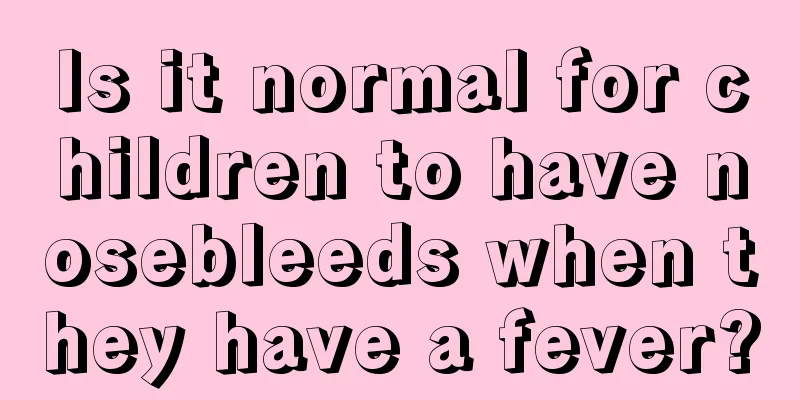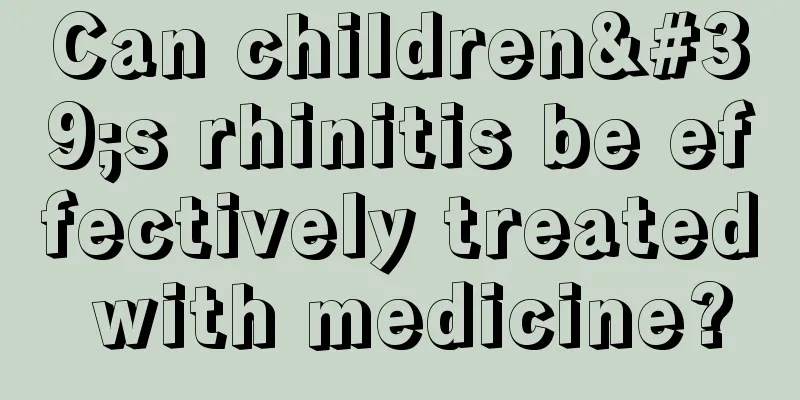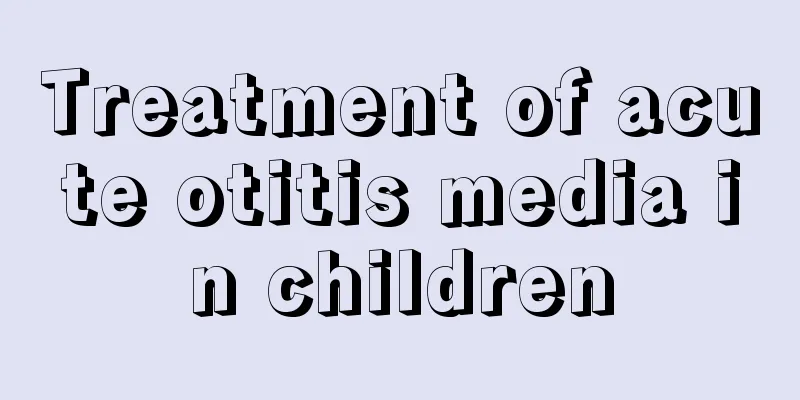Is it normal for children to have nosebleeds when they have a fever?

|
Children's physical resistance is very poor, and they often have fever. The most common fever is a cold. At this time, the child's body will become very weak and their appetite will become very poor. Parents must learn to comfort their children's emotions, especially stay with their children and closely monitor their children's body temperature. Some children will have nosebleeds while having a fever. Is this normal? Is it normal for children to have nosebleeds when they have a fever? Nosebleeds caused by children's colds, fevers, and acute upper respiratory tract infections, either viral or dry, occur when children have colds, fevers, and or have a nosebleed. If a child is found to have this condition, timely treatment should be given: active measures should be taken to reduce fever, stop bleeding or control infection, or take some anti-inflammatory drugs. To stop bleeding, you can take Anluoxue and vitamin C. At the same time, make sure to take anti-inflammatory drugs for treatment. To control the infection, you can take ribavirin and amoxicillin. You can take Anrike and other drugs to reduce fever. If the condition is serious, you should go to a regular hospital for treatment. When children are sick, they should rest and avoid eating foods that can cause inflammation. You should eat more fruits and vegetables, which will help your body recover. Tip 1 When a child has a cold, fever and nosebleed, you can tie a thin rope around the lower part of the child's middle finger. This can stop the bleeding quickly and is very effective. Tip 2 When children have a cold, fever and nosebleed, parents can use garlic to stop the bleeding. The method is to mash the garlic and apply it on the child's Yongquan acupoint or mash the garlic and stick it on the soles of the child's feet with a Band-Aid. Doing this can stop nosebleeds caused by colds and fevers. Tip 3 When a child has a cold, fever and nosebleed, you can use onion juice to treat the nosebleed. Applying onion juice to the nasal cavity is a good way to stop bleeding. Onion juice is spicy, warm and non-toxic. It can disperse blood stasis and stop bleeding. The method is to use the onion juice of the green onion, especially the green onion inside the New Year treatment. Wash the green onion, then use a cotton ball dipped in mucus and plug it into the two nostrils respectively. Use it several times to see obvious results. At the same time, pay attention to eating more vegetables and fruits, drinking more water, eating less spicy and dry foods, and not picking your nose. Factors that cause fever in babies: 1. Non-disease factors The body temperature of infants is easily affected by the external environment: high temperature (heatstroke), wearing too many clothes, insufficient water intake, water loss (sweating, diarrhea), poor ventilation in the room, before and after strenuous exercise, the effects of certain special drugs, and other factors such as preventive injections may also cause fever. If the body temperature becomes unstable, the possibility of illness should be considered. 2. Disease factors Fever in infants younger than 3 months Bacterial infection is the most common (such as group B streptococcus); other infections such as respiratory tract, urinary tract, gastrointestinal tract or otitis media can also cause fever. The most serious infectious disease is sepsis. Therefore, when a newborn has a fever, it is important to take the baby to a doctor for examination so that early diagnosis and treatment can be given. Fever in infants and children older than 3 months The most common ones are colds, otitis media, and urinary tract infections. Otitis media is usually caused by bacteria or viruses from a cold infecting the middle ear through the Eustachian tube. Except for severe otitis media where pus can be seen flowing into the ear, most abnormalities cannot be seen from the outside. |
<<: Why does my child always have nosebleeds?
>>: What should I do if my primary school student has a nosebleed?
Recommend
What to do if your child's front teeth are crooked
A healthy and beautiful set of teeth can make a p...
What are the trace elements in infants?
Everyone knows that trace elements are very impor...
What is the cause of myopia in three-year-old children?
Parents have always regarded their children as th...
15 month old baby has diarrhea
If a 15-month-old baby has diarrhea, it is often ...
There are white bumps on the gums of a six-month-old baby
Many people have this perception, thinking that a...
What to do if your baby's fingers are red and swollen
When babies are still relatively young, they like...
What can children eat to cure runny nose quickly?
It is well known that children have relatively po...
What's the matter with the baby's nose having horizontal lines?
Generally speaking, infants and young children, e...
What should I do if my child's bone age is too high?
In modern society, due to many reasons, some chil...
What are the precautions for baby deworming?
Many people may have had deworming when they were...
When will the baby's fontanelle close and what should I do if it closes prematurely?
The baby's fontanelle will close automaticall...
What's wrong with the baby with blue veins on the bridge of the nose?
What is the matter with the blue veins on the bab...
Pathology of juvenile rheumatoid arthritis
Juvenile rheumatoid arthritis is a very harmful d...
How to treat yellow tongue in baby
The tongue of our human body is very important. O...
Why do children often have foot pain?
We all know that children are lively and active b...









